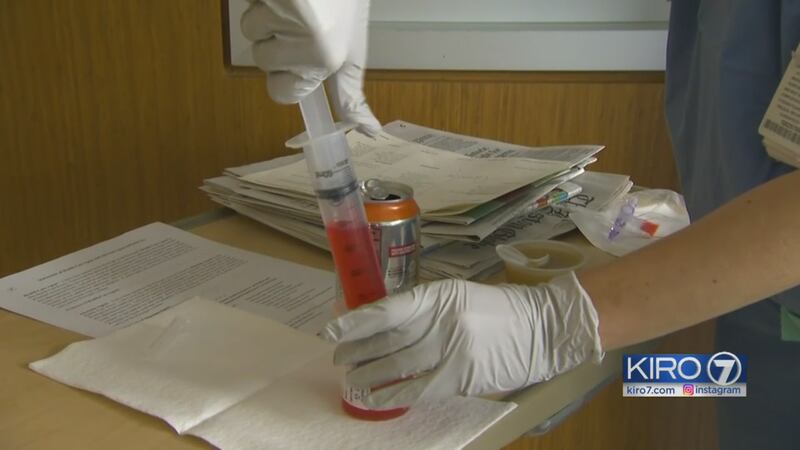Just as Washington faces a potentially severe flu season, health-care providers in the state are being affected by a shortage of fluid bags used to administer hydration and drugs.
As a result, two of the region’s biggest hospitals have made changes to patient care, staffing and procedures.
After Hurricane Maria ravaged Puerto Rico in September, knocking out several drug and medical-supply plants, health authorities knew there'd be a shortage of medical products.
Chief among them are intravenous (IV) bags. The clear plastic bags hang above a patient and are used to quickly administer drugs and fluids. The bags dilute the drugs before they enter a patient’s blood stream at a specific rate — the so-called IV drip.
Administering drugs and fluids directly into a patient’s vein can be done much more quickly and in a more controlled fashion than by giving patients drugs or fluids by mouth. Using an IV also is usually the only way to get drugs and fluids into an unconscious patient or when a patient has a breathing or other type of tube going into his or her mouth.
Scroll down to continue reading.
Trending headlines
- WSU QB Tyler Hilinski found dead in apparent suicide
- 'Hearts are broken' as fallen deputy laid to rest
- Police: Man with 'ornate umbrella' thought to be rifle causes hospital lockdown
- Fallen deputy's organs extend life for wounded soldiers, partner said
- Man killed in Tacoma break-in and shooting
Replenishing fluids through IV drips is also a component in treating the flu.
Deaths from influenza are on the rise in the state. As of last week, seven people had died this season in Pierce County.
“If we can’t support patients coming in emergency rooms who have influenza, more people are going to die,” predicted Deborah Pasko, director of medication safety and quality at the American Society of Health System Pharmacists. “I see it as a crisis.”
After last year’s hurricane, MultiCare Health System’s Tacoma General Hospital organized an internal task force to prepare for the anticipated shortage of IV bags, spokesman Mark Swart said.
Recently, with the shortage of bags affecting hospitals all over the nation, Tacoma General implemented a variety of solutions, Swart said.
One of those workarounds is to administer drugs directly into a patient’s vein or access port, sometimes called an IV push.
Additional conservation methods include administering fluids and drugs orally as well as closely monitoring and evaluating the patient’s need for fluids.
An additional pharmacy tech has been working at Tacoma General for the past few weeks to accommodate the extra work caused by the shortage, Swart said.
Each hospital’s shortage differs in products, quantities and timing. Hospitals pull from a variety of wholesalers who in turn use different manufacturers.
A spokesman for St. Joseph Medical Center in Tacoma said the shortage has not affected the hospital.
“Our supply chain has been successful in keeping all of our facilities full of IV solutions and has not experienced any outages,” Cary Evans said.
A nurse at St. Joseph told The News Tribune the hospital has been experiencing occasional shortages of smaller saline bags. The nurse asked not to be identified because they were not authorized to speak with the media.
A hospital official declined to specifically address that allegation.
“Common hospital practice dictates that if an occasional shortage of one size exists, another sized is used,” the spokeswoman said.
Small bags, instead of larger versions, can cut a chemotherapy infusion time from eight hours to two. They are also crucial for patients who need an antibiotic infusion every few hours or for patients on fluid restriction.
Patients at Olympia’s Providence St. Peter Hospital have not been affected by the shortage, spokesman Chris Thomas said. Because the hospital is part of a large health system in seven states, it is able to shift supplies.
“Our patients can feel confident that we are doing everything necessary to ensure a steady supply of safe and approved IV products and medications at our facilities,” Thomas said.
Part of that, according to records obtained by The News Tribune, included creating a three-page action plan should a shortage hit the hospital.
At Harborview Medical Center in Seattle, extra staff has been brought in to deal with the shortage, said pharmacy head Steve Fijalka.
“It’s a lot more work, because it’s a big deal to change how things are set up on your computer, and how you train staff to do things,” Fijalka said.
IV bag maker Baxter said in a statement that its manufacturing plants have been reconnected to Puerto Rico’s devastated electric grid and are back in production.
Food and Drug Administration Commissioner Scott Gottlieb said on Jan. 4 that he expects the shortages to ease soon.
“Based on the information we’re receiving from the companies, we expect that the shortage of IV saline fluids will improve in early 2018, with continuing improvements in the weeks ahead,” Gottlieb said.
Story from Craig Sailor: 253-597-8541, @crsailor
The Associated Press contributed to this story.
Cox Media Group








